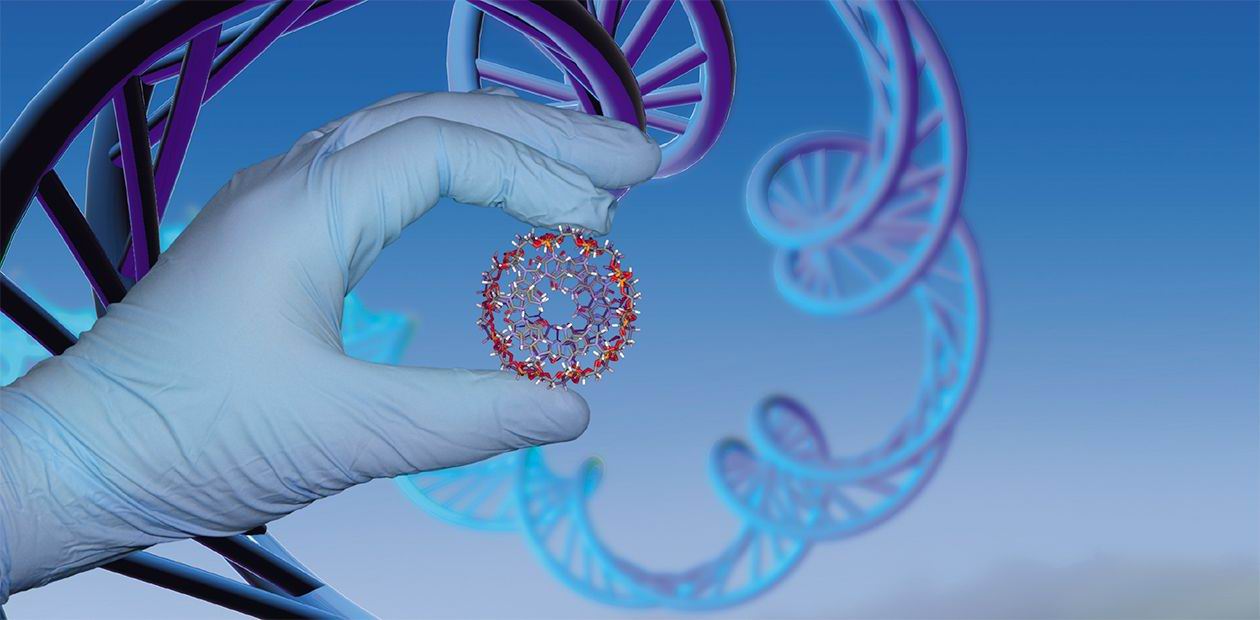Evolution in a Tube
A long-standing dream of chemists and biologists is to learn how to create molecules with definite, prespecified properties that could form the core of molecular devices or new materials with a required biological activity.
Until recently, the main approach to solving this problem was the so-called molecular design. Relying on theoretical considerations and experimentally obtained facts, chemists did their best to predict how a molecule should be arranged to possess the necessary properties. Then the molecules designed were synthesized to verify the fit between the features obtained and anticipated.
Unfortunately, the predictive strength of the state-of-the-art theoretical methods cannot be regarded as high, while the synthesis of new compounds per se is a long and laborious affair. Thus, the creation of novel compounds with the use of the rational design approach inevitably requires synthesizing and examining a great number of various compounds, making this way expensive and inefficient. Moreover, this approach is applicable only when the scientist has a clear understanding of how a particular molecule should be arranged to display the properties demanded. However, this is not a frequent case. So what is the way out?
From design to selection
Puzzled by the need to produce molecules possessing prespecified properties, molecular biologists for the last 15 years have been trying to tackle this problem using another approach — the system utilized by the Mother Nature itself. Putting it more specifically, they tried to create certain conditions for the mechanism of molecular selection to function, as it took place at certain stages of the evolution of living systems.
Methods for producing complex mixtures of various molecules, as well as procedures for automatic selection, from these blends, of molecules with specified properties and their further amplification, have been developed.
The use of this very efficient approach expanded immeasurably the capabilities of scientists in the creation of novel unusual catalysts and receptor molecules to bind various chemical compounds.
Now combinatorial methods are widely used by organic chemists: the “libraries” of organic compounds with various structures are synthesized to “fish out” the desired items with the use of physicochemical methods. However, this task is not as simple as it seems, since one should identify and extract only a small fraction of molecules from the tremendous number. Sometimes, it is a vanishingly small amount of material… When looking for several molecules out of billions, no conventional chemical methods presently available are able to isolate and characterize them — unless there is a possibility to amplify the detected molecules after their isolation. This is why chemists are so envious of molecular biologists, who know how to unrestrictedly amplify the molecules from their libraries of nucleic acids with the help of a marvelous technique — the polymerase chain reaction (PCR).
The essence of the method
The PCR, a method discovered in 1985 and allowing the nucleic acids, DNA and RNA, to be amplified in unlimited amounts, formed the basis for modern molecular selection. With it, a merely astronomical number of copies of each molecule present initially in the solution can be obtained at the final stage of the process.
Yet the first stage of molecular selection is the creation of a pool of manifold molecules, i. e., the construction of a molecular library of nucleic acids. Scientists gave this name to a mixture of nucleic acid molecules with an equal length but differing in their nucleotide sequences. These molecules can be produced by adding simultaneously all four monomers (A, T, G, and C) at each stage of the synthesis of nucleic acids in a specialized automated synthesizer. Note that flanking (terminal) regions with a defined nucleotide sequence are attached to each molecule to perform the PCR.
Molecular selection usually utilizes molecules with a length of 30—80 nucleotides. Thus, the resulting library synthesized will contain the complete set of all the possible sequences — from 430 to 480 variants, that is, on the average about 1048 various molecules! In addition, as nucleic acids are capable of folding in a variety of ways depending on the sequences of their nucleotides, the mixtures obtained contain an immense structural diversity of molecules. It is indeed impossible to deal with the entire library for the purpose of selection; usually, only a “small” part of the library is used, just “nothing but” 1015 molecules, the part which is actually manageable.
Usually, DNA are the molecules synthesized (as it is less expensive and more efficient as compared with RNA synthesis), and they are immediately suitable for selection. However, since RNA possesses a broader repertoire of capabilities than DNA, it is possible, if necessary, to transcribe an RNA copy of the synthesized DNA with the help of the enzyme RNA polymerase and to conduct selection with the use of a similar scheme.
Whatever one wants, one gets
The process of selection of the desired molecules itself commences from the loading of the constructed molecular library onto a column filled with a certain substance capable of binding the molecules of interest. The selection yields certain molecules, of course from those present in the initial mixture, whose complexity is limited for obvious physical reasons. However, a relatively simple modification of the experiment layout allows a powerful natural factor to be utilized, converting the selection procedure into a process similar to the evolution of natural living systems.
The point is that the enzymes involved in copying during the replication of DNA molecules can be forced to make “small” mistakes. As a result, mutations are introduced into the molecules selected, and the final set of molecules becomes somewhat different from the initial set — a complete analogy to the corresponding natural process. Certain mutations can confer more fitting properties on the molecules which, naturally, will be accumulated in the mixture during reiterated selection stages. What is this but a true mini-evolution in a tube!
Upon completion of the selection, it is necessary to determine the nucleotide sequences of the champion molecules, for which purpose they are tested and examined individually. The entire process, from its very beginning to the end, takes several weeks, and should it be automated, just several days. Such a selection allows obtaining the so-called RNA aptamers, binding particular molecules (from the Latin aptus, appropriate, fitting), or ribozymes (fused from the two terms —“ribonucleic acid” and “enzyme”, the latter typically meaning a protein entity), catalyzing particular reactions.
By the way, the first reaction at a glance on nucleotide formulas is distrust. It is perplexing how such molecules can be used as catalysts — after all, they lack any groups that would be appropriate for catalysis! Nonetheless, via selecting a particular, apt spatial molecular structure, the RNA catalysts contrive to achieve an outstanding efficiency even being relatively short, 30—80 nucleotides in length. One can only wonder at the might of the Darwinian evolution, which works even on the molecular level.
The uniqueness and strength of the method of molecular selection lies in its simplicity. We have absolutely no need in any preliminary knowledge about both the target molecules to be selected and the mechanism of the recognition process itself. We just use the universal scheme designed earlier; however, this simple, “brute force” method instantly gives excellent results.
Moreover, it is possible to select not only aptamers or ribozymes, but also molecules with any other properties, the main point being to devise a procedure for selecting the molecules of interest. Molecular selection is a most efficient method due to its fastness, which is achieved through concurrency of the processes and a tremendous number of molecules tested simultaneously.
“Utilitarian” ribozymes and aptamers
During 15 years since molecular selection was invented, a multitude of ribozymes catalyzing various reactions and having a potential for actual practical application were selected in many laboratories. Among them, there are ribozymes performing RNA aminoacylation; the formation of amide, peptide, and glycoside bonds; RNA alkylation, phosphorylation, polymerization; and many other reactions.
Perhaps, the ribozymes capable of cleaving RNA molecules have attracted the greatest attention. Such ribozymes are widespread in nature; however, this method allowed considerably more efficient RNA and DNA catalysts to be selected.
The molecules in question consist of certain (flanking) nucleotide sequences that bind to the target RNA and the catalytic region that cleaves the target. Each ribozyme is able in such a manner to “exterminate” a host of the target molecules. An evident application of such molecules is as therapeutics: for cleaving either viral RNA or “surplus” RNA, i. e., the RNA that are produced by the organism in excess amounts in some diseases. A number of such preparations are currently at the stage of clinical trials, including Herzyme, the drug intended for cancer therapy and directed against the human epidermal growth factor (Her2).
The method of molecular selection enabled the selection of thousands of aptamers forming specific complexes with various organic compounds and biological molecules, including growth factors, enzymes, antibodies, receptors, and viral proteins. It is even feasible to create aptamers for an entire organism, for example, for a bacterium, which will bind to various structures on its surface. Many of such aptamers were produced for solving practical problems.
In the mechanism of their action, aptamers essentially resemble antibodies, the proteins produced by our immune system for the purpose of recognizing and combating alien substances that entered the bloodstream. However, aptamers additionally possess a number of unique features, rendering them somewhat superior to antibodies. For example, a living organism or a tissue culture is required to produce monoclonal antibodies. However, aptamers are produced by selection in a tube, and further the sequences are chemically synthesized, which is a considerably quicker, cheaper, and simpler method. Moreover, the chemical synthesis always ensures a precise error-free sequence and the highest quality.
It is possible to obtain aptamers that would bind to any substances, whereas antibodies can be produced to rather a narrow range of substances that are nontoxic to the organism. As for aptamers, they are produced in a controlled manner, thereby allowing any salt concentration, any acidity, any temperature, etc., to be used in the process. Moreover, aptamers are nontoxic, induce no allergy, can be modified by (are modifiable by the introduction of) additional chemical groups, and are stable when stored.
Unusual medicines
The aptamer for the blood clotting factor IXa, produced recently, is among the most of well-known examples. The essence of this issue is the following: In clinical practice, blood must not clot during surgery, and anticoagulants, special substances that prevent blood clotting, are administered for this purpose. However, the most important problem after the surgical intervention is a rapid wound healing. Here, anticoagulants, which aided in successful surgery, create a high postoperative risk due to voluminous bleeding, which may even end in a lethal outcome. Therefore, the effect of such a medication should be neutralized by a specific antidote.
Currently, heparin is widely used as an anticoagulant, as it is the only substance of this kind with an available antidote, polypeptide protamine. Unfortunately, the use of heparin has certain limitations; in addition, toxic effects were reported for this drug.
To expand the range of anticoagulants, molecular selection was performed. A modified RNA molecule thus selected is capable of decreasing efficiently the blood coagulability and, unlike heparin, it is nontoxic and nonallergic. Then an antidote was synthesized for the aptamer in question — the so-called antisense oligonucleotide capable of controlling the anticoagulant activity and reverse the effect of the RNA aptamer in a short time. So far, several candidate aptamers for designing the new generation anticoagulants have been produced.
Aptamers have a potential for a wide application in clinical practice as therapeutics. Perhaps, the best studied is the aptamer for the vesicular epithelial growth factor (VEGF), which is a target in the therapy of blood vessel diseases. Although only ribozymes are able to cleave the RNA target, while aptamers only bind to it in a superstable manner, the eventual effect is the same: the synthesis of the “harmful” protein halts.
The modified RNA preparation mentioned above (named Macugen or Pegaptanib) has already passed clinical trials. It is administered for healing macular degeneration, a disease that is the main cause of irreversible loss of vision in the age cohort over 55 years old. The aptamer drug is administered directly into the patient’s eye, and just a few sessions are sufficient for amelioration.
Aside from RNA aptamers, DNA aptamers are also widely used. In both cases, additional chemical groups are introduced into the aptamers to render these medicinal molecules more resistant to the action of cleavage enzymes, more capable of binding to the target, or to provide their addressed delivery in the organism.
Hitting the bull’s eye
In addition to a direct impact on the RNA target, aptamers, similar to antibodies, are capable of delivering small organic molecules (drugs or toxins) precisely to specific cell types. For example, in the cancer therapy, aptamers “recognize” specific receptors on the surface of cancer cells and bind to them releasing their deadly burden, thereby eliminating these cells in a specific fashion.
Aptamers are also widely used for the detection of undesirable proteins, targets for therapeutic action, due to their ability to bind specifically and stably to molecules, thereby inactivating them. In fact, the overwhelming majority of drugs are based on small organic molecules, and for efficient therapy with these drugs one should obviously know the level to which particular protein should be decreased in order to cure the disease.
An evident use of aptamers in medicine is also the detection of various molecules. For example, in some cases it is possible to immobilize an aptamer specific to a certain molecule on the surface of a plate. A sample to be tested is applied to the plate. If the sample contains the molecules sought for, they quickly bind to the aptamer. Then a second aptamer labeled with, for example, a fluorescent group and capable of recognizing the complex of the first aptamer and the target molecule is added. The fluorescence of the plate upon its washing indicates to the presence of the molecule sought for in the sample assayed; the absence of fluorescence indicates that the second aptamer has been completely washed off from the plate.
It was shown that with the help of such schemes aptamers can be used for the quantification of very small amounts of E class immunoglobulins in blood samples, which is unachievable by using conventional monoclonal antibodies. Aptamers provide a highly specific detection of tumor markers, suggesting their utility for the diagnostics of certain cancer types. They also may find application in emergencies and hostilities, when it is necessary to rapidly assay the samples for the concentrations of toxic agents.
A new stage — protein selection
By making the experimental systems slightly more complex, molecular biologists succeeded in applying the principles and approaches of molecular evolution to produce protein molecules with prespecified properties. Anyhow, the protein is synthesized according to genetic programs that are nothing but DNA nucleotide sequences.
Taking an ordinary molecular library of DNA sequences as a program, as it was used in the selection experiments to produce aptamers, and then performing protein synthesis on this template, we will obtain a set of protein molecules of similar complexity as the DNA library. If a method for selecting the protein molecules according to their functional properties and a method for the amplification of the DNA programs encoding these proteins are devised, the problem will be solved.
Two variants for solving this problem have been realized today. In the approach named “ribosome display”, the translated protein remains bound to the ribosome (the cellular element that assembles the protein molecules) and the messenger RNA (mRNA) that encodes it. This particular three-component complex is used for selection.
In the case of the so-called “mRNA display”, the messenger RNA that encodes the protein is translated and then attached to the synthesized protein. The resulting hybrid molecules are purified from the ribosome components and used for selection. Experiments with the use of these schemes produced highly specific and stably binding peptides, antibodies, and enzymes.
Following the route of molecular evolution
It took molecular selection just a few years from the time it was invented to find numerous applications in various areas of molecular biology, biochemistry, and medicine. This range turned out to be very wide — from fundamental science (the hypothetical “RNA World”) to practical applications in biotechnology and medicine, in-cluding diagnostic tools and drugs. This method of “brute force”, based on combinatorial approaches and molecular selection, finds an ever-expanding application in both research practice and applied works. Automation of the processes utilized in the selection experiments and development of efficient robotics are boosting its efficiency, allowing problems of ever-increasing comp-lexity related to the creation of mole-cules with specified properties to be solved.
Evidently, the next step in further development of molecular selection is the construction of more intricate systems that will allow for the creation of not merely “smart molecules” but, for example, simplest artificial cells for the purposes of biotechnology. After all, the evolution is inherently a nonstop process…
The Editorial Board thanks V. V. Koval, Candidate of Science in Chemistry (Institute of Chemical Biology and Fundamental Medicine, Siberian Branch of the Russian Academy of Sciences) for his assistance in the preparation of illustrations















